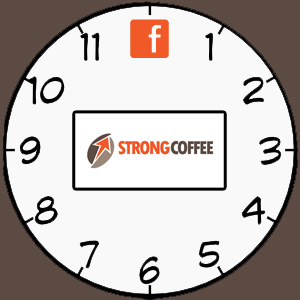Facebook Timing and Reach
If you manage or run a Facebook page you might notice that different posts have varying degrees of reach and engagement. There are a number of different factors that effect this difference. It can be frustrating when you post what you consider high quality content and the reach for your post is below average. Aside from engagement, one big factor that effects your potential reach is the timing of your post. A post can have varying degrees of reach or carry depending on the time of day it is posted. That’s why its important to understand your audience as well as your audiences’ Facebook habits.
Using Facebook Insights
In your page’s insight tab you can break down all of your pages stats and insights. Under the “Posts” tab there is a section labelled “When Your Fans Are Online”. It looks something like this:


This particular example is from one of our clients’ pages. As you can see, there is a steady flow of people online from 7am to 10pm. The peak point is 9pm, but from that point forward the audience dips down for the night. You might also notice a mini-peak at noon. The most probably assumption for this is lunch time. There is also a slight positive slop from 3pm onward, the assumption for this is that people are finishing work, coming home and logging on to Facebook at differing times.
Taking this information and using it to your benefit can be a tricky task. The obvious goal is to get the most people as possible to see your post. You might assume that posting at 3pm would be your best bet as this would give you all the 3pm to 9pm traffic. However, what must be taken into consideration is the fact that 3pm posts will be farther down the 9pm users’ timeline, running the risk of going unnoticed to your audience.
You might also assume that posting at the peak-time of 9pm would give you an optimal audience reach. However, by posting this late you run risk of posting too late and missing out on some of the earlier crowd. As mentioned above, finding the best possible time to post is a tricky task, and fluctuates from page to page. The best way to figure out is through experimenting. Try posting at slightly different times, and keep track of the results. Another thing to keep in mind is the day of the week. Some time of days work better for certain days of the week. For instance, the example client above had less fans online Monday and Tuesday compared to the rest of the week, over the past week. A lot factors into the reasoning behind this. Events, festivals,concerts, sporting events, and television shows are just a few things that come to mind that could effect Facebook audience numbers. This is particularly important if your page is a local page. Since our company is based in Edmonton, we have come to the realization that posting during an Oilers game is never a great idea. You’ll want to keep local events in mind when thinking about your Facebook posts.
Combining Timing with Content

The actual content of the post should be considered as well when thinking about post timing. For instance, if your post is about dinner you will most likely want to post prior to dinner, at the time when people are thinking about dinner. Similarly, if your post deals with active lifestyles, the early morning crowd might be your best bet. The point being, reaching your highest potential audience might not actually be your best option. You want to reach the people who will engage with the post’s particular content. This is especially important when you post a number of different types of posts for one page. Your audiences’ interests can fluctuate immensely, so posting something about a restaurant’s supper menu might not flyover so well at 9am, but that very same post might do wonders at 3:30pm.
So what we’re really getting at here is engagement. The goal isn’t necessarily to reach the biggest audience possible, but the largest relevant audience. Having your audience like, share, and comment on posts furthers the posts’ longevity and reach. Think of it as a domino-effect. Let’s say you post something at 7pm. One of your fans sees this post, enjoys the content and shares it at 7:30pm. This will show up in their friends’ feed at 7:30pm and beyond. You have effectively furthered the time-span of your post.
You’re also building a two-way flow of communication and interaction. You’re not just speaking to your audience, you are having a conversation with your audience. People like to talk about what they’re interested in. So if the content you post doesn’t interest your audience, they won’t engage. Timing posts in correlation to the context of the post can help provide better engagement.
Don’t Forget Time Zones
One thing we haven’t mentioned yet is that Facebook Insights shows the time as it is your page’s timezone. This means, if you’re posting to a national or international audience, you’ll want to adjust the time accordingly. Facebook Insights also gives a fan breakdown by location, so perhaps you have a larger audience in a different city than you reside and it would make sense to cater to their time zone. These are all things to take into consideration.
Final Thoughts
There are many different components to making an excellent Facebook post. Timing your post correctly is essential for optimal audience reach. Having said this, there is no cookie-cutter, one-size fits all, blueprint or formula for Facebook post timing. Every page is going to be different and similarly every post is going to be different. Judging when your highest fan reach will be is just part of the process. Custom timing the post in accordance to the content is another key component. Finally, taking into account location when determining Facebook post-timing is recommended, particularly if your fanbase reaches across far geographical distances or crosses timezones. Since there isn’t a single answer for when to post Facebook posts, it comes down to experimenting with different types of posts in different time periods and using traditional marketing methods of connecting content to audiences. Happy posting everyone!




